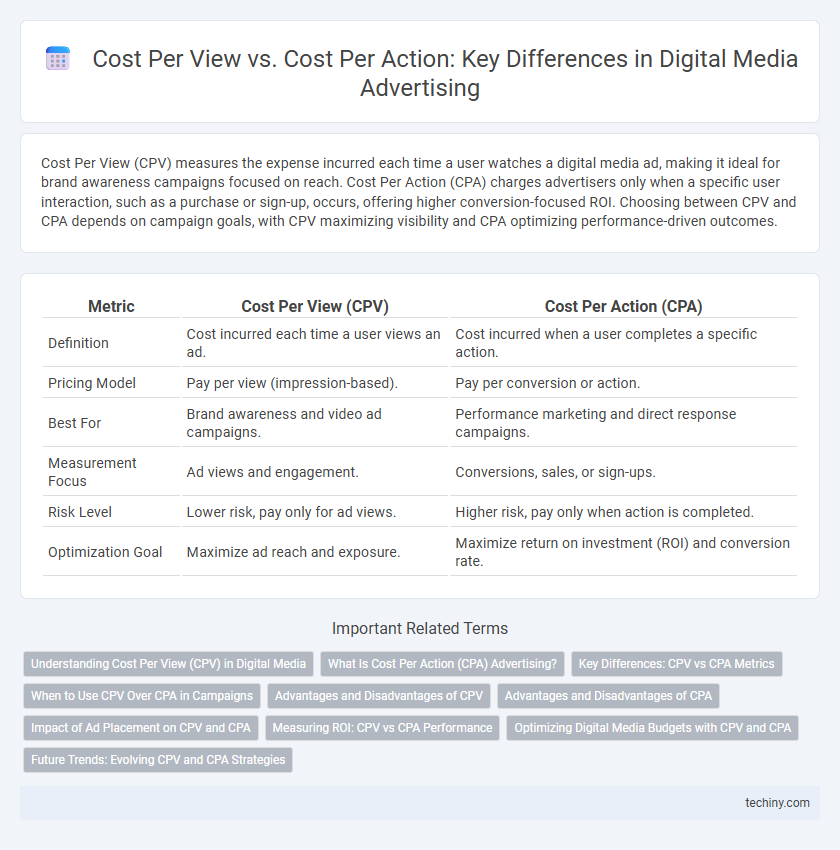Cost Per View (CPV) measures the expense incurred each time a user watches a digital media ad, making it ideal for brand awareness campaigns focused on reach. Cost Per Action (CPA) charges advertisers only when a specific user interaction, such as a purchase or sign-up, occurs, offering higher conversion-focused ROI. Choosing between CPV and CPA depends on campaign goals, with CPV maximizing visibility and CPA optimizing performance-driven outcomes.
Table of Comparison
| Metric | Cost Per View (CPV) | Cost Per Action (CPA) |
|---|---|---|
| Definition | Cost incurred each time a user views an ad. | Cost incurred when a user completes a specific action. |
| Pricing Model | Pay per view (impression-based). | Pay per conversion or action. |
| Best For | Brand awareness and video ad campaigns. | Performance marketing and direct response campaigns. |
| Measurement Focus | Ad views and engagement. | Conversions, sales, or sign-ups. |
| Risk Level | Lower risk, pay only for ad views. | Higher risk, pay only when action is completed. |
| Optimization Goal | Maximize ad reach and exposure. | Maximize return on investment (ROI) and conversion rate. |
Understanding Cost Per View (CPV) in Digital Media
Cost Per View (CPV) in digital media measures the expense incurred each time a viewer watches a digital ad, providing advertisers with a clear metric for video engagement. Unlike Cost Per Action (CPA), which charges based on a specific user action such as a purchase or signup, CPV focuses solely on the ad view itself, making it ideal for brand awareness campaigns. Optimizing CPV campaigns involves targeting relevant audiences and crafting compelling content to maximize viewer retention and impact while controlling costs.
What Is Cost Per Action (CPA) Advertising?
Cost Per Action (CPA) advertising is a digital marketing model where advertisers pay only when a specific action, such as a purchase, sign-up, or download, is completed by a user. CPA campaigns optimize ad spend by focusing on direct conversions rather than just views or clicks, making it a performance-driven strategy. This method contrasts with Cost Per View (CPV), which charges based on the number of times an ad is viewed regardless of user engagement or conversion.
Key Differences: CPV vs CPA Metrics
Cost Per View (CPV) measures the expense incurred each time a user views a digital ad, primarily optimizing for brand awareness and engagement metrics. In contrast, Cost Per Action (CPA) focuses on the cost associated with a specific user action such as a purchase, sign-up, or download, driving performance and conversion goals. CPV is ideal for campaigns aiming to maximize exposure, whereas CPA provides precise tracking of return on investment through tangible user interactions.
When to Use CPV Over CPA in Campaigns
Cost Per View (CPV) is ideal for brand awareness campaigns where the primary goal is maximizing video views and audience reach without immediate conversion requirements. CPV campaigns optimize ad spend by charging only when a viewer watches the video, making it cost-effective for driving engagement in content-heavy strategies. Use CPV when measuring engagement metrics and exposure is more critical than direct sales or leads tracked in Cost Per Action (CPA) models.
Advantages and Disadvantages of CPV
Cost Per View (CPV) offers advertisers a direct way to pay only when a user actually watches a video ad, increasing engagement tracking precision in digital media campaigns. However, CPV may lead to higher costs without guaranteed actions such as clicks or conversions, limiting its effectiveness in driving sales or leads. The main advantage of CPV is brand exposure through video content, but its disadvantage lies in the lack of measured user intent beyond viewing.
Advantages and Disadvantages of CPA
Cost Per Action (CPA) offers advertisers precise budget control by charging only when a specific action, such as a purchase or sign-up, is completed, ensuring higher ROI compared to Cost Per View (CPV). However, CPA campaigns typically require more advanced tracking and optimization, increasing setup complexity and initial costs. While CPA reduces wasted spend on non-converting views, it may limit reach and brand awareness compared to CPV models.
Impact of Ad Placement on CPV and CPA
Ad placement significantly influences both Cost Per View (CPV) and Cost Per Action (CPA) by determining the audience quality and engagement level. Premium placements on relevant platforms often reduce CPV through higher viewability while improving CPA by targeting users more likely to convert. Strategic ad positioning enhances overall campaign efficiency by maximizing impressions that lead to meaningful actions and lowering wasted spend.
Measuring ROI: CPV vs CPA Performance
Measuring ROI in digital media campaigns requires comparing Cost Per View (CPV) and Cost Per Action (CPA) based on specific performance metrics. CPV focuses on the expense incurred for each video or ad view, ideal for brand awareness and reach campaigns. CPA measures cost relative to completed actions such as purchases or sign-ups, offering a more direct assessment of conversion efficiency and revenue impact.
Optimizing Digital Media Budgets with CPV and CPA
Cost Per View (CPV) focuses on paying for each video view, making it ideal for brand awareness campaigns with measurable audience engagement metrics. Cost Per Action (CPA) targets specific user actions like sign-ups or purchases, offering higher conversion efficiency for performance-driven marketing goals. Optimizing digital media budgets involves analyzing campaign objectives to allocate spending between CPV for reach and CPA for conversion, maximizing ROI through data-driven adjustments.
Future Trends: Evolving CPV and CPA Strategies
Future trends in digital media reveal a shift towards more sophisticated Cost Per View (CPV) and Cost Per Action (CPA) strategies driven by AI-powered analytics and real-time audience segmentation. Advertisers are increasingly leveraging machine learning algorithms to optimize CPV campaigns by predicting viewer engagement and improving targeting precision. Meanwhile, CPA models are evolving with enhanced attribution techniques and blockchain verification, ensuring transparent and accountable conversions across multiple digital touchpoints.
Cost Per View vs Cost Per Action Infographic

 techiny.com
techiny.com